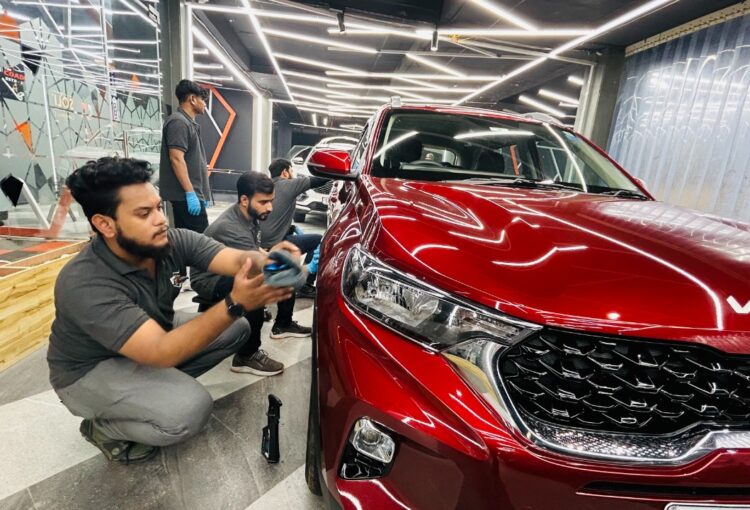
As a detailing expert in India, I have a lot of customers asking me about the best ways to protect their car’s paint. Two popular options are ceramic coatings and paint protection films (PPF). Each of these products offers unique benefits and drawbacks, so it’s important to understand the differences and determine which is right for your vehicle.
What is Ceramic Coating?
Ceramic coatings are a liquid polymer that is applied to a car’s exterior. It creates a strong chemical bond with the paint and acts as a protective layer against water, UV rays, infrared radiation, chemicals, and other harmful environmental factors. Ceramic coatings create a hydrophobic effect that makes water bead up and roll off the surface, making it easier to clean and maintain a glossy finish.
Benefits of Ceramic Coatings for Your Car
Ceramic coatings provide many benefits for your car, including:
- Long-lasting protection – Unlike wax or sealant, ceramic coatings last for several years and can withstand heavy environmental exposure.
- Shield against scratches – Ceramic coatings create a hard barrier over your paint that can deter minor scratches.
- Easier to clean – The hydrophobic effect of the coating makes water, dirt, and grime slide off easily.
- Improved appearance – The ceramic coating enhances the depth and clarity of the paint, making it look brighter and richer.
Difference Between PPF and Ceramic Coatings
On the other hand, PPF is a film made of thermoplastic urethane (TPU) that is installed onto the car’s exterior to protect it from physical damage like scratches, dents, and rock chips. PPF is both flexible and durable, providing a hard barrier that can withstand high impact. Unlike ceramic coatings, PPF absorbs the impact and dissipates the energy of the collision.
Protecting Your Car’s Paint: PPF vs. Ceramic Coating?
PPF is ideal for those who are mainly concerned about physical damage like scratches and dents. Ceramic coatings are better suited for those who want long-lasting, all-around protection against the elements.
Pros and Cons of Paint Protection Film
PPF offers many benefits, such as preventing physical damage, providing a high-gloss finish, and protecting your car’s resale value. However, it can be expensive, and installation must be done by a professional.
Understanding Ceramic Coating: A Complete Guide
If you’re considering ceramic coating for your car, it’s essential to understand some of the top qualities to look for to ensure you’re getting the best value. One of the most important factors is the level of silica dioxide, which can vary from 70-90 percent. A quality ceramic coating should have higher levels of silica dioxide for maximum protection and durability.
Should You Use PPF or Ceramic Coating on Your Car?
The answer depends on your priorities, financial resources, and how you use your car. If you prioritize protection against environmental factors like heat, chemicals, and UV rays, you may choose ceramic coating. If you prioritize protection against physical damage from rocks, road debris or daily scratches and dings then PPF is a preferable option.
PPF vs. Ceramic Coating: Which is More Effective?
Both PPF and ceramic coatings are effective at protecting your vehicle’s paint against their specific threats. The ideal choice for you depends on what threats you’re most worried about.
What is the Best Way to Protect Your Car’s Exterior?
The best way to protect your car’s exterior is to use a combination of both PPF and ceramic coating. By applying PPF to areas that are prone to physical damage like the front bumper, hood or any other high rock chip prone area you can provide your car with heavy-duty physical protection against the environment. Meanwhile, ceramic coating to the remaining areas around PPF (out of areas of high impact) can provide your vehicle with comprehensive all-round protection against weathering, UV rays, and other environmental factors.
Paint Protection Film vs. Ceramic Coating: Which is More Affordable?
PPF can be expensive since professional installation is required, and the material isn’t cheap either. Ceramic coating also requires professional installation, but it’s typically less expensive than PPF.
Can PPF and Ceramic Coating be used Together?
Yes, both PPF and ceramic coating work well together. PPF provides a strong physical barrier while the ceramic coating protects against environmental damage.
How Long Do PPF and Ceramic Coating Last?
The average lifespan of PPF is 5-10 years depending on usage, while the ceramic coating lasts around 2 to 5 years. Please note these – mentioned range depends on usage and maintenance
How to Maintain PPF and Ceramic Coating?
PPF requires wiping it down regularly with a wet microfiber towel, and also you have to avoid washing the car with a high amount of pressure. Harsh chemicals like bug and tar remover should be avoided. Ceramic coating requires routine washing and drying with a pH-neutral car soap and a soft, non-abrasive sponge to remove dirt and debris.
The Science Behind PPF and Ceramic Coating
The science behind a ceramic coating is in the car detailing industry is proprietary. The specific formulations of ceramic coatings and how they bond with the paint are more mystery than knowledge to most users. Conversely, automotive engineers began researching polyurethane films during the 1960s seeking a less restrictive foam layer. TPU is now used in PPF and has evolved in the creation of dent-resistant truck bed liners and other applications.
Tips for Choosing the Right Paint Protection for Your Car.
Choosing the right PPF or Ceramic coating for your vehicle depends on your priorities, how you use your car, and the amount of money you’re willing to spend. Be sure to seek advice from experts in the industry, like the professionals at workshops specializing in ceramic coatings or paint protection films to find the optimal solution for your vehicle.
The process of deciding what kind of paint protection to use and how to apply it, can be stressful for some people, but don’t let it deter you from taking the necessary steps in ensuring an extra layer of protection to your beloved vehicle that you’ve spent your hard earned money on. Remember that whichever you choose, it is an investment in the long-term health and performance of your car.
Pushpinder singh

